Do you leave your SIB in the water over an extended period? Say, for the entire season? It’s more convenient than having to constantly assemble and disassemble your boat, that’s for sure.
But there is a problem.
Leaving your boat in the water for extended periods will result in biofouling.
Nature is incredible. A marine ecosystem will start developing on a submerged object within 24 hours, starting with bacterial adhesion. In a week, microalgae forms. In 2-3 weeks, macrofoulizers attach.
This process is what leads to the formation of marine growth and barnacles.
Contents
Why are barnacles and marine growth bad for your boat?
Ignoring marine growth on your inflatable boat is a bad idea. Even though they are small and seem harmless, they have an outsized effect on the hydrodynamics of boats.
The bottom of your boat is smooth. Protruding barnacles create hull-drag, which reduces the performance of your SIB. This results in more fuel usage.
Did you know that tests show that on planing powerboats, just a small amount of barnacle build-up can reduce the boat’s speed by 5 knots? It also increases gas consumption by 30%. This has a profound economic impact.
Barnacles can also become a safety hazard, since they can be sharp and cut your feet under water while swimming.
Not to mention the fact that you simply cannot deflate and store an inflatable boat with barnacles on it.
Stage 1: How to remove barnacles from your SIB?
Getting rid of biofouling is not going to be a gentle process. There is no quick way of doing it, unfortunately.
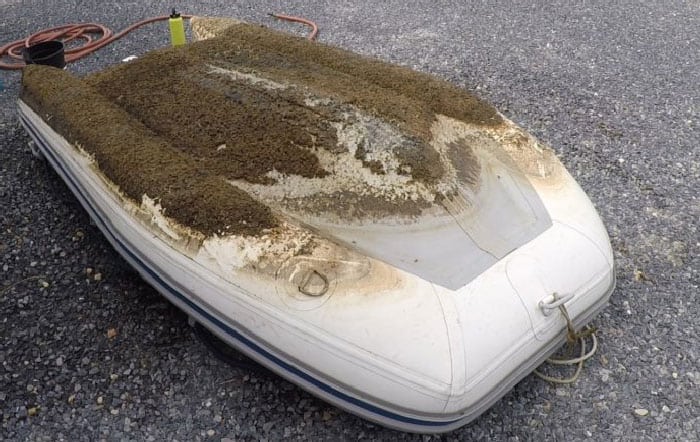
Here are the steps to remove barnacles from your inflatable boat, they are the same for both PVC and Hypalon:
- Take your boat out of the water. This isn’t evident to some.
- Turn your boat over to give you access to the hull. This is where most marine growth occurs.
If you have the time and place, leave your bottom like this in the sun for a day. The sun will kill the marine ecosystem by then. This is optional though, and may not be a good idea for PVC boats. - Get a pressure washer and spray the bottom of your SIB with the washer set to LOW. This will remove any slime, loose barnacles, debris.
I want to emphasize that the power washer needs to be set to the low position! You can easily puncture the rubber with a strong power washer, or even tear the seams apart. - Put on heavy work gloves, you’re about to go into close combat. You will be scraping the barnacles off, so you need the work gloves to protect your hands from cuts.
It is best to use plastic objects to scrape the barnacles off. I have heard of people using
windscreen scrapers, plastic kitchen spatula, and even old credit cards successfully.
Use care! Excessive gouging and scraping can damage the hull.
After finishing this stage, you should be free of barnacles.
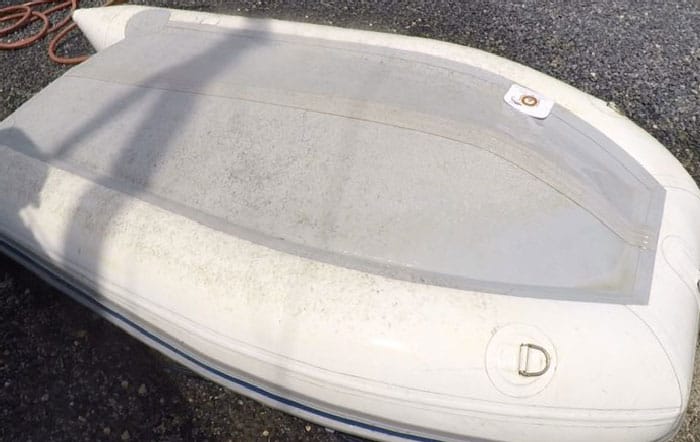
If you are putting your boat away for the winter and have space to store it inflated, there is another option. After you take the boat out of the water, get a stiff brush, scrub the bottom well, then rinse the boat off. Leave it inflated during the winter in a dry place, and the barnacles will dry out during this time. They should pop right off in the spring.
Stage 2: Removing calcium rings left from barnacles
After you remove all of the marine growth from your boat’s hull, you will most likely be faced with the next phase of the barnacle-cleaning process: cleaning of the calcium rings.
This is what it looks like, they are small white discs that just won’t budge.
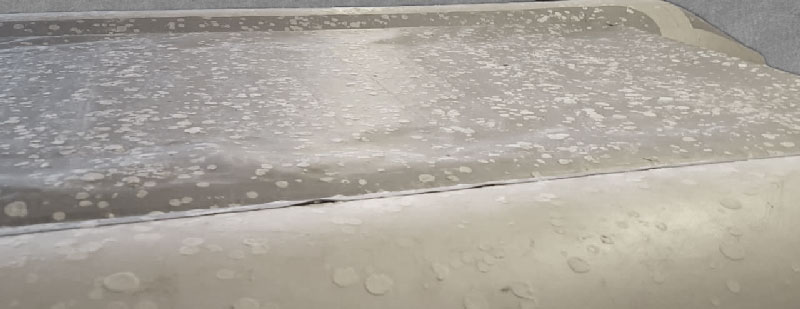
As I mentioned, these are thin calcium disks, sort of like limescale. Depending on the level of marine growth you cleaned off, they might cover your entire hull.
A lot of people damage their boat at this stage, as the disks are not removable if you don’t know the correct method (which I’ll show you below).
Do not use sanders or scrubbing agents. They will remove the fabric’s rubberized coating quicker than the discs. You might even scrub through the material. On the same note, don’t try to pry them off. Little bits of rubber will pry along with them. (If you already damaged your boat like this, try using liquid rubber repair paint to fix it).
The only way to remove these calcium disks is by using an acidic solution.
Depending on how bad the situation is, there are 3 ways you can go. You will want to put on latex gloves before using either solution below, to protect your hands from the acidic chemicals.
Vinegar
You might have used vinegar to remove limescale at home already, which works nicely thanks to the acidity of vinegar loosening the calcium (vinegar is a dilute solution of carboxylic acid).
The calcium disks left by barnacles are no different. This vinegar method is the first thing you’ll want to try, especially if you only have a few barnacle rings to remove.
The way to use vinegar to break up barnacle deposits is to mix a splash of dishwashing soap with highly acetic vinegar. The dishwashing soap suspends the vinegar and helps break up the calcium.
You will have to leave the vinegar solution on the boat for hours, maybe even a day for it to loosen the rings properly. This is the main disadvantage to the vinegar method to remove barnacle rings, it just takes a really long time to work.
In the end, you should be able to wash off the calcium deposits with a hose.
Citric acid
Citric acid is also a carboxylic acid, but it can be purchased in powder form, meaning it is much more concentrated than vinegar. You probably don’t have any citric acid powder laying around at home though, that’s why I recommend using vinegar first.
You can buy 100% pure citric acid on Amazon of course.
Using citric acid powder is actually cheaper and more convenient than vinegar, as it is easier to store. If you have a persistent barnacle problem, or just have lots of barnacle rings, you may just opt to try this method instead of the vinegar one.
The usage method is the same as with vinegar. Dilute the citric acid powder in water, and leave it on the boat. Wash it off when the calcium rings have loosened.
Hydrochloric acid
Using hydrochloric acid is the quickest way to get rid of barnacle rings. Don’t worry, a dilute acid solution won’t burn through your boat, but it will burn your hand if it comes into contact with your skin.
Here are the steps to using acid to remove the rings:
- Buy 35% muriatic acid (this is the non-technical grade of hydrochloric acid)
- Dilute the acid into the water at 5 parts water, 1 part acid.
Important: pour the water out first, and pour the acid into the water. If you do it vice-versa, so pore water into acid, it will boil and splatter. - Splash or spray the acidic solution onto the affected areas carefully.
- Wait 10-20 minutes, maybe 30 minutes with Hypalon boats (as they are tougher), and hose off the acid. It dissolves the calcium rings into a goo, which will be easy to wash off with a hose.
There are a few important things to keep in mind here:
- Wear latex gloves if you try this method!
- Do not make the solution too concentrated.
- Do not leave it on your boat for too long.
- Make sure you do this in a location where the acid rinse will not cause any harm. Ideally, there should be a drain right under your boat when you do this.
- You might want to have a sodium bicarbonate solution nearby to neutralize the acid in case you splash it on yourself.
This is by far the fastest method, and should be safe if you exercise caution.
How to prevent barnacles from forming on an inflatable boat?
Sometimes you have no choice, but to leave the boat in the water for extended periods. Maybe you are towing a dinghy behind a mother ship. Or you left the boat at a dock.
Whatever the reason, know that marine growth will start growing on any submerged object, including your boat’s hull, and even your submerged motor.
Obviously, you want to pull your motor out of the water.
As for the hull, you can buy anti foul bottom paint for inflatable boats, which is said to have effect for 1 year.
I have personally never tried this, but I know somebody who keeps his inflatable dinghy at a dock all year round, and does this.
He uses the inflatable boat bottom paint from TotalBoat.
It can be used on PVC and Hypalon boats as well.
Let me know if these tips on removing barnacles worked for you in a comment please!

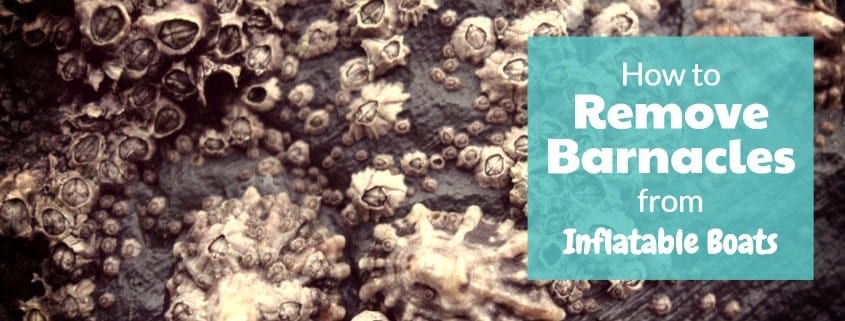
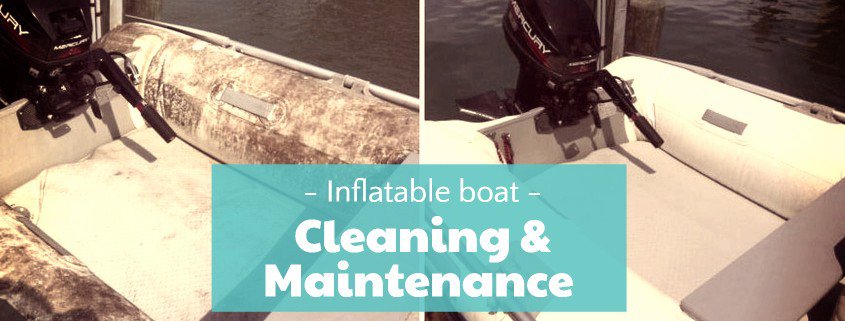
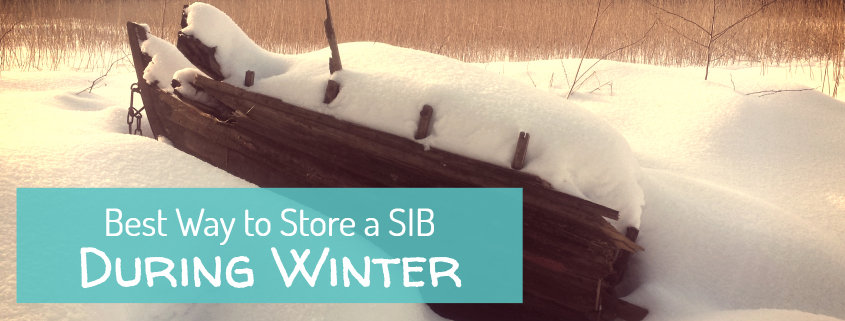
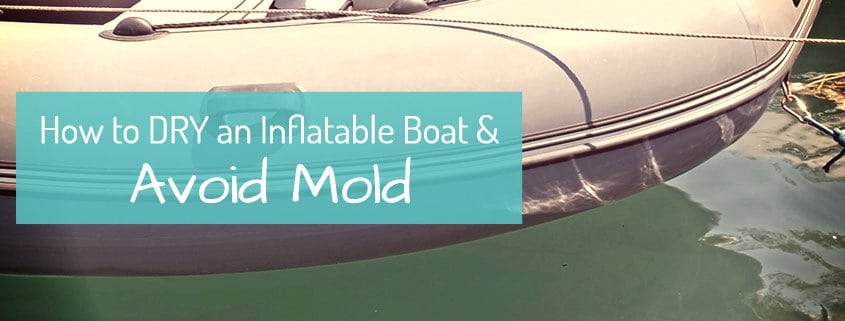
Hi,
I scraped my dingy after 4 weeks in sea water, and whoa, a marine exosystem all its own! Scraping fresh seemed easy. On the barnicle rings, I used a household descaling spray – it foams up and is meant for shower heads and the like. It worked great until I ran out and switched to vinegar. Both, used in conjunction with a pack of green 3M scrubbing pads got most of the millions of spots off. Yours was a great description – someone who has done it. Some of these online how-to things are obviously written by someone who has no idea – so they have no detail. Thanks.
Thanks, finaly i got rid of the rings,, but i used ½ – ½ mixture of Hydrochloric acid water., and yes, wear googles.
But nice description.
Daniel from Denmark
Two things: Vinegar is dilute acetic acid, not carboxylic. It is a mild organic acid. Citric acid is similar in that it also is a mild organic acid. Hydrochloric acid on the other hand is a strong mineral acid that will burn the hell out of you if you get it on your skin, even diluted. So, my second point is that you should be wearing goggles as well as impermeable gloves when using hydrochloric (muriatic) acid, and be extremely careful to protect yourself and others. Dr. D.
Hi, acetic acid is a saturated carboxylic acid (source1) (source2).
Yes, wear gloves when handling acid.